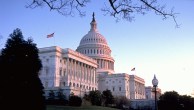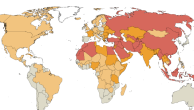For most of the nation’s history, public religious displays were not controversial. But in recent decades, a growing number of citizens and civil liberties groups have sued towns, cities and states over religious symbols in the public square, arguing that these displays should be removed because they violate the First Amendment’s prohibition on government establishment of religion. Indeed, every holiday season, controversies arise over the placement of nativity scenes, Christmas trees and Hanukkah menorahs on public property. Meanwhile, a steady stream of lawsuits has been filed challenging the permanent placement of religious symbols, such as the Ten Commandments, on and inside courthouses and government buildings.
As part of a new series of occasional essays on the relationship between government and religion, the Pew Forum on Religion & Public Life has published a legal backgrounder on the public religious displays controversy. The essay details the history of the debate and examines the significant Supreme Court and lower court cases that make up the jurisprudence in this area.
As a supplement to the backgrounder, one of its authors, Robert W. Tuttle, spoke with the Pew Forum about how the current law might be applied in certain circumstances, including a recent religious display controversy in Louisiana.
Featuring: Robert W. Tuttle, David R. and Sherry Kirschner Berz Research Professor of Law and Religion, George Washington University Law School
Interviewer: Robert Ruby, Senior Editor, Pew Forum on Religion & Public Life
FORUM: Let’s begin with the rules. What if the winter holiday season is approaching and a mayor or county executive wants to know what public holiday displays are and are not allowed. What advice should a lawyer give?
TUTTLE: As with clients in all contexts, lawyers give them advice that includes a range of options, from choices that are most easily defended to those most difficult to defend. The first thing I’d ask is, “Why do you want to do this?” If the purpose is to express support for a particular religious message, I would suggest 1) that it’s not particularly appropriate for a political leader to use the government to do that, and 2) that it’s the one sure path to failure.
But there will inevitably be plausible secular reasons for wanting to have holiday displays. The winter holiday season is certainly among the most important, both economically and culturally for folks. I’d say, “Be conscious of the pluralistic character of your community.” Whether you know it’s pluralistic or not, it is. Believers and nonbelievers in Christianity and in other faiths are all going to be seeing this display, and you need to think about the message that you want to send. Do you want to send a message of hospitality, warmth and welcome? Or do you want to send a message that can potentially alienate people – not just those who are hypersensitive, but people of ordinary sensibility?
As part of an inclusive holiday display, a manger scene could be permitted because that has, in some way, become part of the culture, even though it’s loaded with religious meaning. But if the display also has overt religious messages being broadcast over speakers, or if people are playing roles in the crèche and telling the story of Christmas, then that would shift a constitutionally defensible display of shared culture into a message of active religious engagement. So, the display needs to be inclusive – welcome other faith traditions, and emphasize the cultural and historical symbols of the holiday. It also needs to avoid explicit religious messages.
FORUM: Let’s say a fraternal organization in 2007 wants to donate a monument with the text of the Ten Commandments and wants it displayed on public property. Let’s say a second fraternal organization wants to donate a monument with some of the words of the Prophet Muhammad, all of them about the importance of peace and peaceful endeavors; that second fraternal organization also would like its monument displayed in a public place. What should a mayor or county executive do in this situation?
TUTTLE: As with any administrative action, you need to have a policy because if these decisions are made on an ad hoc basis they are very difficult to defend. Therefore, jurisdictions should develop policies about the kinds of monuments they will accept. They also should designate the appropriate political or administrative body to decide whether a monument will be accepted and to determine how the location for a particular monument will be chosen.
The second thing I would want to know, as a practical matter, is whether these organizations are willing to pay the jurisdiction’s legal costs for defending the lawsuit that might follow. For jurisdictions that are short of money, defending a lawsuit of this sort can be a very expensive enterprise. As I frequently tell the congregations that I represent, not all gifts should be proffered or accepted.
FORUM: There have been some newspaper articles about a recent fight over a picture of Jesus in the lobby of a Louisiana courthouse. How would a court go about determining whether this picture violates the Establishment Clause?
TUTTLE: If the picture is not removed and the American Civil Liberties Union brings suit, then the case will likely be resolved by a court that will examine the content and context of the display, as required by the Supreme Court’s opinions in the Ten Commandments decisions. As for content, the display is certainly less religiously inclusive than the Ten Commandments – it’s more like the crèche in the Allegheny County courthouse. The message in the picture of “Jesus as lawgiver” has a very strong basis in the Christian tradition but doesn’t have an obvious connection to American history. In other words, it’s pretty clearly a religious message stating that obedience to Jesus brings peace. The courthouse displays held unconstitutional in McCreary County made an attempt to link the religious text with American political history, a link that doesn’t seem to have been made here.
As for context, we don’t know anything about the original reason for or circumstances of its placement in the courthouse, though litigation would develop these details. The display is permanent, which argues against its constitutionality because it’s much harder to say that a permanent display – as opposed to a holiday display – is simply acknowledging a celebration of the culture rather than promoting the government’s own message. I think it’s highly unlikely – even with changes to the membership of the Supreme Court – that this display would survive a constitutional challenge.
FORUM: Another issue raised in the Forum essay is that of private religious displays in a public forum. Let’s take another hypothetical situation. Let’s say the Ku Klux Klan wants to erect a private display in a public space and have it attended by Klansman at all times. Let’s add that there are other groups with equally charged messages that are willing to have attended displays in this public space. What are the rules for these kinds of displays?
TUTTLE: If the government has actually established a public space, like a town square, where private speech is allowed, the government cannot regulate the content of that speech. However, it can regulate the manner of the speech. It can say, for example, no use of bullhorns or amplifiers, or it can say it will only allow displays that are attended and that it won’t just let people leave the displays there. But all of those are content-neutral restrictions; they apply to everybody who wants to speak there, whatever it is that they want to say. Even content-neutral restrictions must be reasonable and must further a government purpose. The question would always be, “Why is the government saying it wants only attended rather than unattended displays, or displays of this particular size and no bigger?”
FORUM: Would the Supreme Court’s decisions allowing the public display of nativity scenes and Hanukkah menorahs have been different if the displays at issue had been, for example, Wiccan symbols or symbols to commemorate the ‘Id al-Fitr, the holiday that marks the end of the Islamic holy month of Ramadan? Is there a different standard for symbols of the Judeo-Christian tradition than for symbols of other religious traditions?
TUTTLE: It is unlikely that we would have had the same level of litigation or tumult because there’s just not the same kind of public pressure to create those kinds of displays. When most people look at a display of a very small minority religious group, they are not likely to see it as the government’s voice. They have enough sense of demographics, and enough sense of who was elected to run the government, to think, “I may have stumbled into an unusual town, but my guess is that there are not a whole lot of towns in the country that have a majority of Wiccans on the school board or on the city council.” We’re more likely to see the display just as an acknowledgment that some people in the town are celebrating and we share their joy because we are their neighbors, rather than thinking that the government is celebrating. If you see a majority symbol, it is more plausible to think that the government is celebrating. That said, if the display suggests that the government is promoting the religious message of a minority faith, it’s just as much a violation of the Establishment Clause as if the government were promoting the message of a majority faith.
That’s the difficult but necessary line between the government’s promotion of a religious message and situations in which the government is simply saying, “We share the joy of the season with our friends who are worshipping in this variety of ways.” The latter, I think, is perfectly respectable for a government that understands itself to be the political authority of a nation whose people are very religious. But it’s a tough line to draw.
For a longer discussion of the history of the debate over public religious displays and the significant Supreme Court and lower court cases that make up the jurisprudence in this area, read the Pew Forum on Religion & Public Life’s essay.




